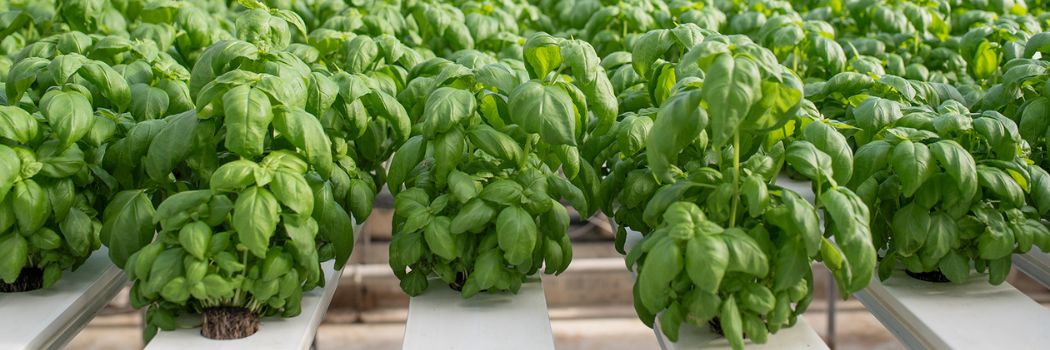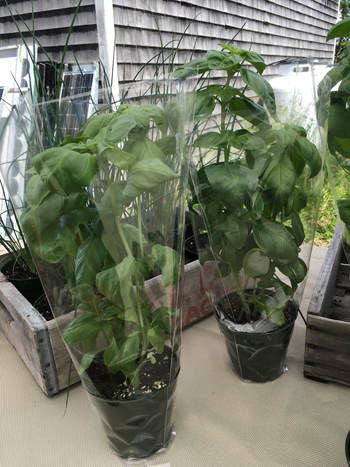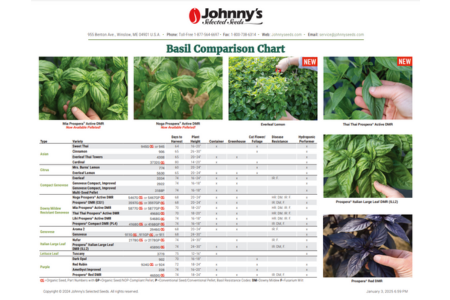- Basil Downy Mildew and Prospera® DMR Basil | Breakthrough Breeding Innovation Provides Solutions
- Prospera® DMR Basil Comparison Chart | Johnny's Selected Seeds
- Video: Prospera® Red Downy Mildew-Resistant Basil
- Video: Prospera® Downy Mildew-Resistant Basil
- Basil | Key Growing Information
- Basil Varieties | Comparison Chart (PDF)
- Hydroponic & Container Basil Guide | Production Advice & Variety Recommendations
- Hydroponic & Container Basil Guide | Printable 4-pp Brochure (PDF)
- Ornamental Basil | Key Growing Information
- Basil Downy Mildew Awareness & Prevention | Tech Sheet (PDF)
- Common Pests & Diseases of Basil | Tech Sheet (PDF)
- Video: 'Everleaf' Basil | The extremely slow-to-bolt, compact Genovese basil
- Beyond Blossoms | Expanding & Diversifying Your Dried Floral Menu
- Getting Started in Cut-Flowers | Top 15 Cuts
- Heat & Drought: How Flower Farmers Are Adapting to Changing & Challenging Climatic Conditions
- Building a Better Market Bouquet: Tips, Techniques & Recipes for Flower Farmers
- Johnny's Edible Flower Guide | Printable 4-pp Brochure (PDF)
- Sustainable Farming Methods | A Survey of Flower Farmers' Best Practices
- Just Add Flowers | An Introduction to Companion Planting for Vegetable & Herb Gardeners
- Succession-Planting Interval Chart for Herbs
- Mia Prospera® Active DMR – Organic Basil Variety from Johnny's
- Lihi Prospera® Active DMR – Organic Basil Variety from Johnny's
- How and When to Prune (Pinch) Basil
- Noga Prospera® Active DMR – Organic Basil Variety from Johnny's
- Webinar Slide Deck | New-for-2023 Vegetables & Herbs | PDF
- Video: High-Value Crops & Varieties for Your Garden • Tutorial with Niki Jabbour
- Video: Disease-Resistant Basils from Johnny's • Tutorial with Niki Jabbour
Hydroponic & Container Basil Guide: Production Advice & Variety Selection
By Hillary Alger, R&D, Herbs Product Manager
Basil is a popular crop for container and hydroponic production because of its high value, ease of production, and quick crop time (approximately 28 days under optimal conditions, in hydroponic systems).
In this guide, we will first provide some production information and tips. Then, we'll help you identify the basil types and varieties that will perform best for your system.
Production Essentials for Hydroponic Basil Growers
Unlike some field crops that can grow with little attention for extended periods of time, hydroponic crops, basil included, require daily management and will do best when environmental variables are tailored to crop-specific needs. Of primary importance are temperature, pH, light, daily light integral (DLI), electroconductivity (EC), and nutrient composition. In general, basil prefers warm temperatures, a moderately acidic pH, and relatively low EC levels, and responds well to high light levels. Specific requirements can vary, however, depending upon the growing system, time of year, and other factors. We recommend the following general conditions for hydroponically grown basil:
- Temperature: 65–70°F (18–21°C).
- pH: 5.8–6.2 (slightly higher in aquaponic and organic systems).
- Light: Minimum 14 hours per day.
- DLI (Daily Light Integral): Minimum 12 mol per m2 per day or higher; basil performs well with high light levels.
- EC (Electroconductivity): 1.0–1.4mS/cm, depending on the season; during winter, crops need a higher EC than during summer.
- Nutrient Solution: Choose a solution specific to herbs and leafy greens and appropriate for your water type, and follow package directions to achieve the EC level listed above.
For more information on monitoring and managing nutrient and light levels, take a look at our comprehensive article on Hydroponic Seed Starting for Healthy Hydroponic Seedlings.
If you are new to hydroponic growing, you may also wish to read our Introduction to Hydroponics, which covers the basics of the most common hydroponic growing systems.
It is advisable to grow basil in isolation from other crops so that you can adjust the nutrient solution and other environmental variables as needed; basil grown under conditions optimized for another crop may not perform well.
We encourage you to conduct your own on-site trials to determine the input levels and environmental conditions that work best in your growing system.
Tips for Container Basil Growers
Most commercial growers use 3–6"-diameter pots for retail herb production. For basil, we recommend a 4"-diameter pot to provide a balance between efficient use of growing space and producing plants of a size optimal for market appearance and value.
Seeds can either be sown directly into the retail container or into a plug tray and after 2–3 weeks of growth, transplanted into the retail container to finish.
The seeding rates (number of seeds per container) that we recommend below represent a wide range: Using fewer seeds will produce an attractive container, provided the plants are grown under optimal conditions, with plenty of light, space, and time for plants to fill out. Using more seeds per container will produce a fuller appearance for finishing at an earlier stage of production, but the plant will outgrow its pot sooner.
| SEEDING BASIL | ||||||
|---|---|---|---|---|---|---|
Pot Diameter (inches) |
Recommended Seeding Rate (Seeds/Container) |
Weeks to Saleable Product |
||||
4 |
5–15 |
4–6 |
||||
![]() For additional cultural recommendations, refer to our Basil Key Growing Information.
For additional cultural recommendations, refer to our Basil Key Growing Information.
The End Product
There are several primary ways that full-size (non-microgreen), container- or hydroponically-grown basil is marketed:
- Live plant with growing medium still attached.
- Live plant in nursery container/pot.
- Individual leaves or bunches packaged in bag or plastic clamshell container.
- Baby-leaf crop grown in hydroponic raft system, harvested at 4–6" in height, packaged in bag or plastic clamshell container (less common end product).
Placing the live product within a protective sleeve can help prevent plant damage at market and extend shelf life.
How to Select Basil Varieties for Hydroponic or Container Production
Nearly all basil types and varieties can perform well in hydroponic and container growing systems, but which ones will perform best for you? Characteristics to consider include: growth rate, disease resistances, plant habit, leaf types, yield, and the flavor/aroma profile.
Plant Habit & Growth Rate
For live plant sales, varieties that produce compact, attractive, full, and uniform plants are ideal.
If individual leaves or bunches are the primary end product, however, variety selection is driven more by leaf type, yield, and flavor–aroma profile than by plant habit.
Regardless of the end product, slow-to-bolt varieties extend the harvest window and fast-growing varieties speed crop time for a faster turnover.
To compare plant habit and growth rate (along with other distinguishing characteristics), refer to our Basil Varieties Comparison Chart.
Flavor, Yield & Leaf Type
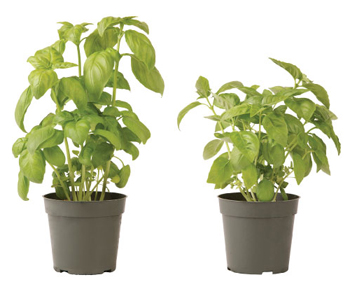
There are two primary types of green basil, each with distinguishing flavor, yield, and leaf type features.
- Genovese basil is prized for its classic pesto flavor and characteristic, heavily cupped, spoon-shaped leaves. Genovese is largely the preferred type for culinary use.
- Italian Large Leaf basil is known for being highly productive. Plants are dense and produce large, pointed, rugose (wrinkled) leaves that are typically thicker and more durable than the leaves of Genovese type varieties. That durability, coupled with strong yields and quick growth, are the reasons why some growers prefer the Italian Large Leaf type, although its lighter green leaves and sweeter flavor profile is considered less refined than those of the Genovese type. Discerning basil consumers will pick up on the stronger notes of anise or cinnamon commonly present in this type of basil.
In addition to the standard green basil types commonly grown in North America, there are Red/Purple, Citrus, Asian/Thai, and Lettuce Leaf basils. Each offers specific features and qualities of color, flavor, and culinary use.
Disease Resistance
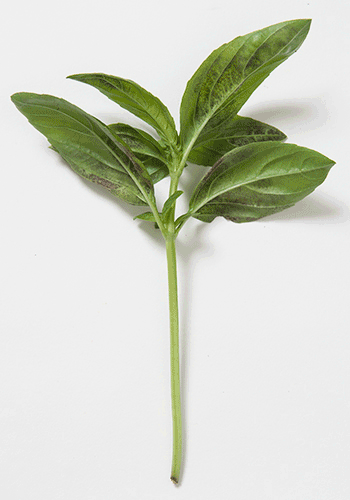
The two most common diseases of basil are basil downy mildew (DM), a water mold, and Fusarium wilt (F), a fungus. Selecting disease-resistant varieties can be helpful when disease pressure is a problem.
- We offer a series downy mildew-resistant (DMR) varieties that offer a stronger level of resistance than the first-generation varieties. The pathogen is a rapidly evolving one, however, and multiple strains (or races) of downy mildew have been identified in different geographic regions, so we suggest trialing a few different varieties to see which work best for your region.
- We recently connected with 3 individuals whose line of work puts them face-to-face with basil downy mildew. Read our report of our interview on variety development, grower success, and monitoring, reporting and management: Basil Downy Mildew and Prospera® DMR Basil • Breakthrough Breeding Innovation Provides Solutions.
- For more information on identifying and preventing this disease, see our Basil Downy Mildew Prevention Tech Sheet.
- All of our basil seed lots are lab-tested to confirm the absence of seedborne Fusarium, and we also offer a range of Fusarium-resistant varieties.
Learn More
Refer to the following resources for additional guidance on growing hydroponic and container basil.


